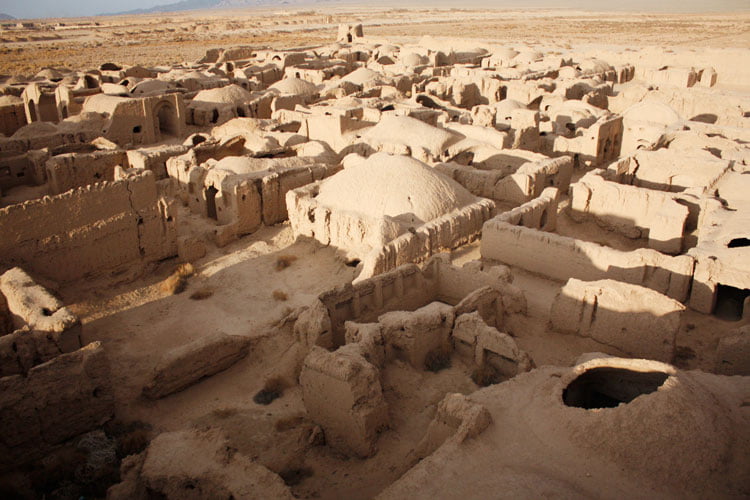The city of Miigon is located 23 km northwest of Lashgark and between Feshm and Shemshak, and the valley of Ahyghark, which ends on the northern ahar, and finally the fortress of the city of Shahrkhk. At the northeastern part of the city of Mihon, two other valleys, the Valley of Hamoon (The same) and the melon of the valley, which flows into the Valley of the Strait of Ben.
The monuments and historical monuments around and along the path are: the temple of the palace of the city (the temple of Nahid) around Sugar Ab, the Palace of Anisdaloule from the Nasir al-Din Shah period in Oshan-a collection of monuments and houses of the city of Miyogun in the body of the four valleys above has been constructed. Part of the city and the houses that are on the river side that reaches Shemshak to the city are Maigon.
On the sides of the river, two streets were constructed south-north parallel to each other, and they are called the witness blvd. The old texture of MiGon city and most of the cultural-historical buildings and old town houses are located in this area of the city. Nowadays, due to new construction, all of them are destroyed and there is no trace of them, even the mosque of MiGON, HUSINIYA and historical city bath They are said to be very beautiful and worthy of being destroyed and renovated during these developments.
Caves around: Caves of Hamlon around Miigon, Kıqbad in the village of Igl, Chah-Chah-Chiang Chiang
mountain. Valuable natural monuments: Mount Khatun Bargah, Various plant species in Lalan
Villages and Recreation Spaces: Sugar Water, Ahar, Miigon, Eagle, Shemshak, Oushan, Roodak , Jajrood River Route of
pilgrimage places: Imamzadeh Taher and Zahed in Sugar Ab, Mohammad Bagher Roodak, Tomb of Shamshak, Lalan, Meigoon, Dasbarz
The city of Pejouz has been divided into two urban areas of MiGon and Maynoun, due to its large size and population and the need for better services.
Address: Lashkarak Road, km 23, MiGon City
Behbad is one of the province's cities 220 kilometers north-east of Yazd. Most of its people are engaged in farming and animal husbandry, and the religion of the people of Islam (Shiites). Agricultural products of this region include wheat, barley, cumin, pistachio, grapes, pomegranate and recently high quality saffron. The tomb of the great Islamic scientist Mullah Abdullah Behbaadi is in this city. The city of Behbad has a long history dating back to the history of the city of Mongolia that it was completely destroyed and rebuilt. It is one of the desert cities of Iran located on the edge of the Lut plain, yet it is a lush city and in The rainfall is relatively high. In the past, grapes were famous for Beabad, but now most of the gardens in this area are related to posts. The ancient name of this city is Tali, with abundant underground water, a large amount of which goes to the Chadermulli mine, which has lowered the surface of the water and, as a result, made it bitter. According to the historic documents, Chadermulli mine area has always belonged to this section, which has been annexed to Ardakan city due to its influence. The local dialect of this region is closer to the dialect of the people of Kerman province. For example, in the end of their words they add "he" like this instead of this and the little one instead of a small one. Nun Kotou can be named after the local meal. Ahmadabad, Kovijan and Bastan, Asfiq is one of the most important villages in this region. In villages around this city, due to the cold weather, walnuts and almonds are grown. Ahmadabad, Kovijan and Bastan, Asfiq is one of the most important villages in this region. In villages around this city, due to the cold weather, walnuts and almonds are grown. Ahmadabad, Kovijan and Bastan, Asfiq is one of the most important villages in this region. In villages around this city, due to the cold weather, walnuts and almonds are grown.
Excerpt:
Bābād consists of two words to and Abad. The word "Bhābād" means "the best" in the name of "conquest" means "admiration" and "pronunciation of fraction" means good and good. Of course, the previous name may have been different from this and it has been renamed because of its destruction and the construction of a new village, which means better than the former villages.
How to get up and date:
The city of Behbazd has a long history, but it has been completely destroyed due to the geographical location of the forests, or by natural factors. Before the Mongol invasion of Iran, Behbad was a Shahri Abad, and the Ismaili sect was built around the fortress in front of the fortress in connection with the fortress of Tabas. The Hakka Khan attacked the region to suppress the sect, and in addition to destroying the castles, the city was equally grounded. The remains of its ruins are still a few kilometers away from the present-day city of Behbazd.
From the Mongol to the Safavid era, there is no accurate information about this region, and historical documents about this city have been written by some writers and historians, including the book Comprehensive Jagheri by Torab Naeini, Bostan al-Sayyah by Sheikh Mahmoud Shabestari, the footnotes of the Great Epic Book by Parizi, The Book of the History of Kerman by Mohammad Ali Khan Vaziri, Yazd Memoirs by Iraj Afshar and Jameh Mofidi by Mohammad Mostofi Bafghi are mentioned in the greatness of the city of Behbad. In 1348, Behbad became the center of the city and in 1362 it became a municipality.
Historical monuments:
Among the historical monuments of the city of Behbaud, it is possible to mention Jame Mosque, Mazar Sheikh Ziauddin, Mazar Mulla Abdollah and some other works. The city of Behbazd has 13 mosques and one Hosseini and 5 other mosques are under construction.
source : seeiran.i


درباره این سایت